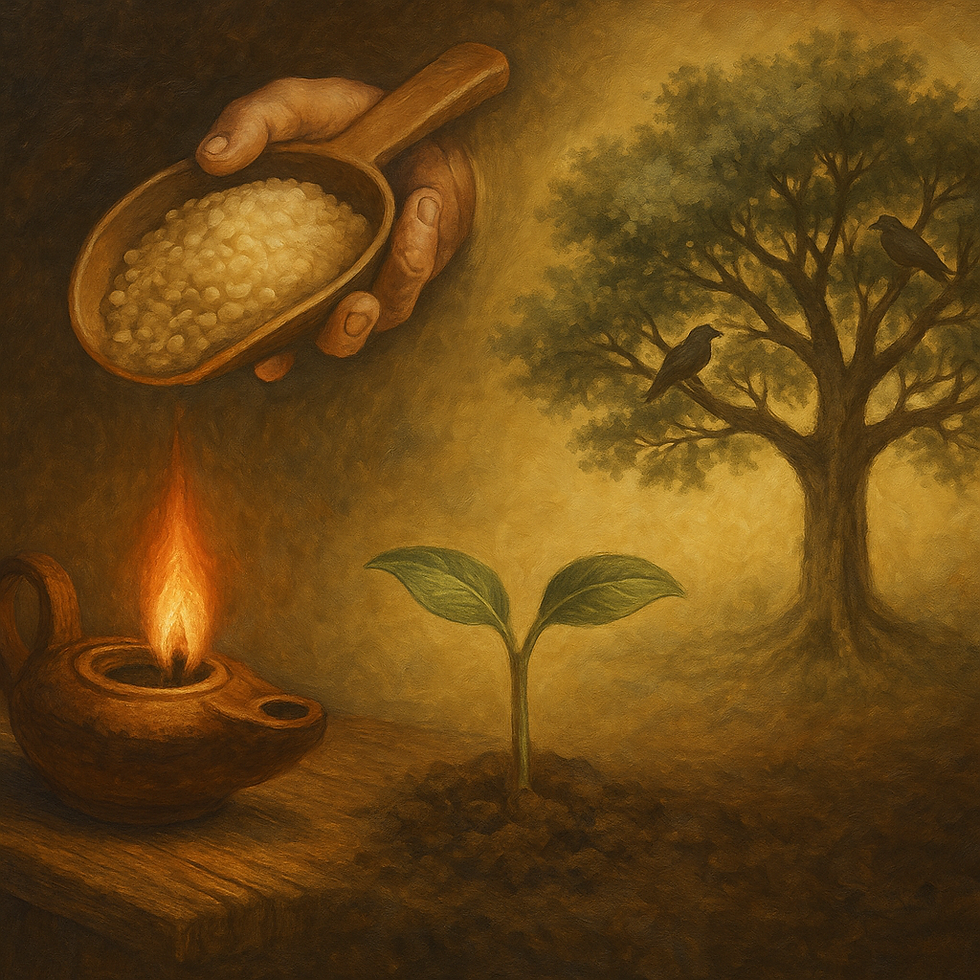Ep. Mark 4:21–23 The Lamp
- Dwaine C. Senechal

- Aug 31
- 3 min read
Updated: Sep 14

Also He said to them, “Is a lamp brought to be put under a basket or under a bed? Is it not to be set on a lampstand? For there is nothing hidden which will not be revealed, nor has anything been kept secret but that it should come to light. If anyone has ears to hear, let him hear.”(Mark 4:21–23 NKJV)
Whenever I read this scripture, I always try to imagine myself being there. The crowds have thinned, and Jesus is still teaching. I picture Him pointing to a simple clay lamp — the kind every home in Galilee had. Everyone knew you don’t light a lamp to shove it under a basket or hide it under a bed. A lamp is made to shine. But what exactly is Jesus telling us here?
As we move through these parables, I want to keep a framework in mind. Each one tells us something about the Presence of the kingdom, the People of the kingdom, or the Principles by which the kingdom operates. Often, they touch on more than one. This short saying about the lamp does all three.
The Presence of the Kingdom
One question I’ve asked is: what is the lamp? Is it the kingdom itself? The message of the kingdom? Or, as Matthew says elsewhere, our good works?
Here in Mark’s context, the lamp points to the message of the kingdom. Jesus has just explained why He teaches in parables: truth may seem hidden for a time, but it is meant to be revealed. In the same way, the lamp may look small and fragile, but it is already lit.
This pushes against a common Western assumption that the kingdom hasn’t come yet — that Jesus will only bring it in the future. But that doesn’t fit what He says here. The lamp is already burning. The kingdom is present now. It may look hidden, but it will not stay that way.
The People of the Kingdom
Another question is who Jesus is talking to. The Greek “you” here is plural — He’s addressing the disciples as a community. Together, they are entrusted with the kingdom’s light.
This means the lamp is not just about my private piety or individual good works. It’s about the church as a people. Will we, together, set the lamp on the stand for all to see, or will we hide it under fear, distraction, or compromise?
Now, Matthew does apply the lamp image to our good works (Matt. 5:16), and that is true as far as it goes. But if I reduce this saying to “be a good person,” I miss the point. All religions have their own forms of good works, and they often look the same. What sets the kingdom apart is not just morality, but witness. The light here is the proclamation of God’s reign through Jesus. That is what the world wants to snuff out. That is the lamp entrusted to the people of God.
The Principles of the Kingdom
Finally, this saying reminds me of a principle that runs through all of Jesus’ teaching: God’s truth cannot remain hidden forever. It may be obscured for a time, misunderstood, even resisted — but it is designed to come to light. The parables themselves work this way. They sift and test the hearers, but eventually the truth shines.
The principle is simple but weighty: the gospel cannot stay buried. What God has lit will shine.
Application
This saying presses me to grapple with all three dimensions of the kingdom.
Presence: Do I really believe the kingdom has already come? If I think it’s still in the future, I’ll act like there’s no light to show. But Jesus says the lamp is already burning.
People: As part of the church, am I helping the light shine, or am I hiding it under my own distractions, comfort, or fear of rejection?
Principles: God’s truth will not remain hidden. The kingdom is not meant to be concealed. My choice is whether to live in alignment with that or to resist it.
The kingdom is here. The lamp is lit. The only question is whether I will put it on the stand, or shove it under a basket.
References
Matthew 5:15–16; Luke 8:16 – Parallel uses of the lamp image.
Craig S. Keener, IVP Bible Background Commentary: New Testament – On first-century household lamps and their symbolic use.
R.T. France, The Gospel of Mark (NIGTC) – Notes on the plural “you” and the kingdom message as the lamp in Mark’s context.




Comments